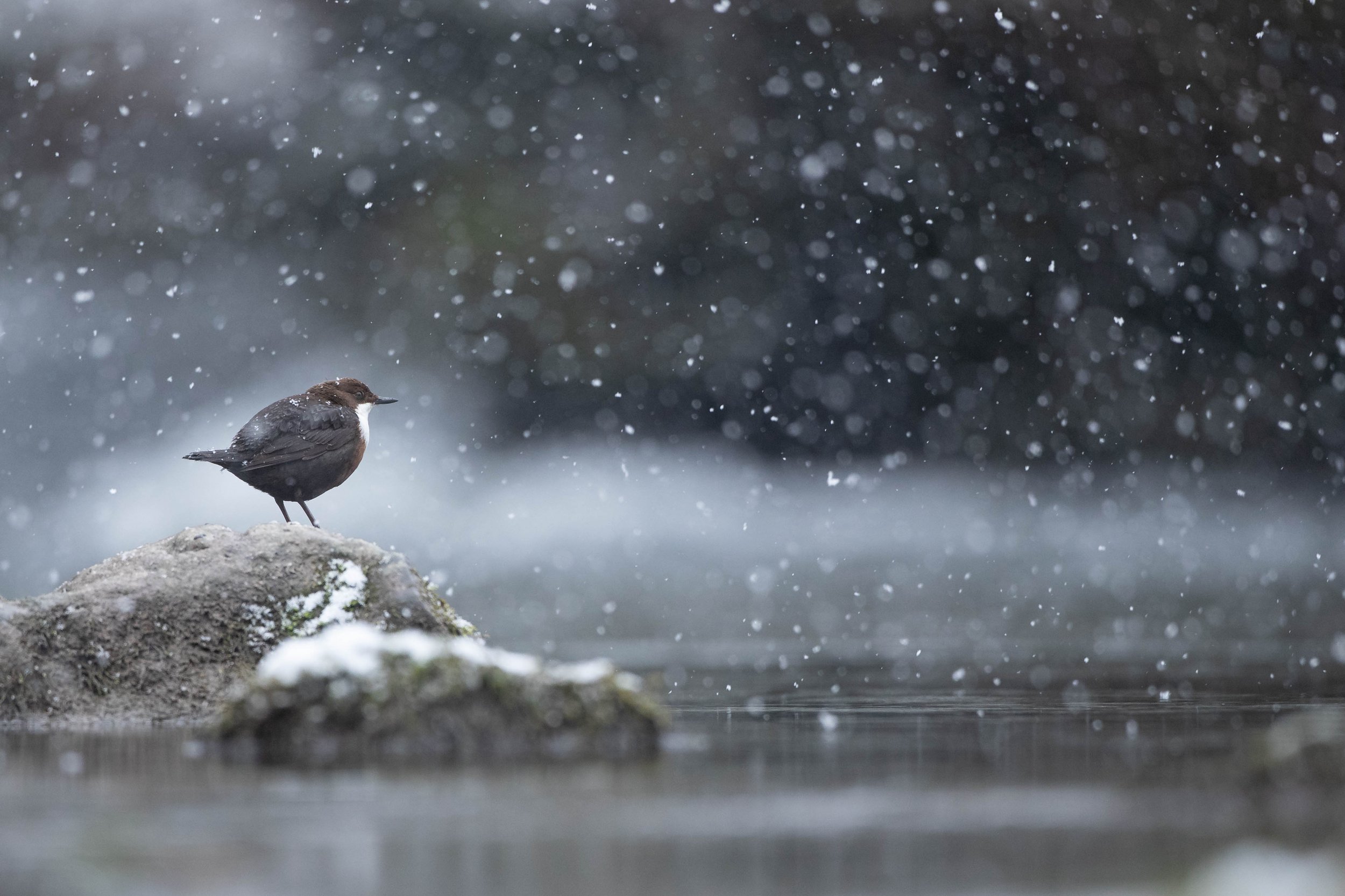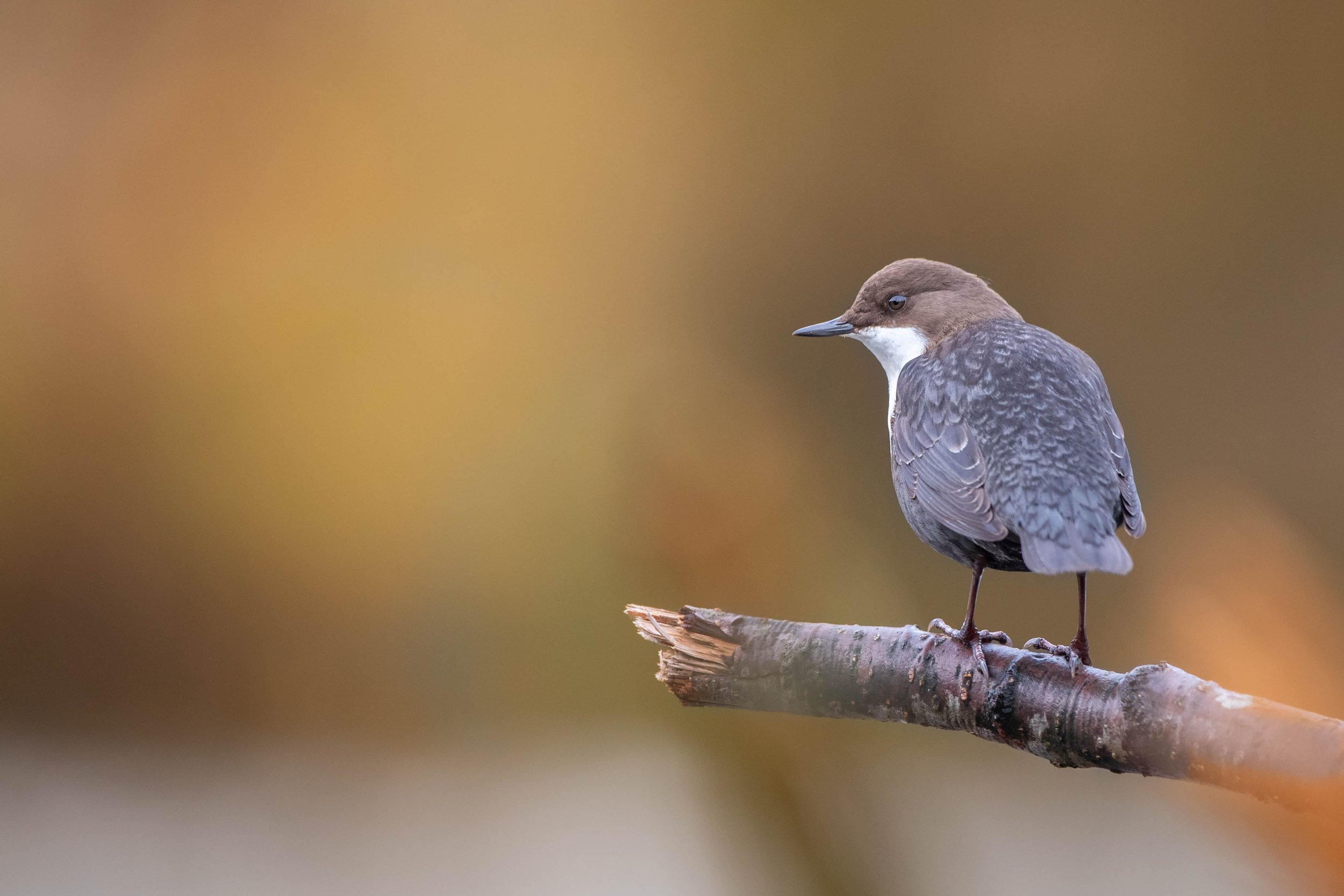Photographing Dippers
The White-throated dipper (Cinclus cinclus), or put simply; the Dipper, is the UK’s only aquatic songbird. Whilst a fairly common sight on many rivers across the UK, hopping on and off rocks and bobbing up and down whilst perched – which is how they got their name, the dipper is a bird that ignited my passion for wildlife photography and I wanted to provide you with a few tips and tricks for finding and photographing these incredible little birds.
Some of you will know already that I grew up on the small island of Jersey, where rivers and much of their associated wildlife aren’t present. In fact, it wasn’t until I was 28 years old and made a trip to Devon to visit family, that I had my very first dipper encounter. I was walking along the River Otter with my now father-in-law, who pointed out a dipper as it flew past us upstream. We walked further up and found it dipping away on a rock and I was completely taken aback with how tiny this bird was. Standing only a few centimetres taller than a European robin, I realised how many times I must have walked along this stretch of river and missed this bird completely. That dipper didn’t stick around too long, but long enough to start what has now become an obsession of mine.
I’ve since learnt some amazing facts about these birds, which has magnified my admiration for them. For example, dippers have transparent eyelids called a 'nictitating membrane', that act as goggles when submerged and they can stay underwater for up to 30 seconds, allowing them to forage along the riverbed.
Fast forward 4 years, I am now lucky enough to live right by the River Otter, where there is a healthy population of dippers and I have therefore been able to spend a lot of time with these birds, getting to witness and learn different behaviours, which I believe is prudent to capturing natural images of wildlife. There are a few things you can do to increase your chances of getting close to these magnificent birds although I must pre-warn you, time spent watching dippers can become very addictive.
The best places to find dippers are along fast-flowing rivers and streams, mainly in upland areas but also on lowland rivers in southwest England. Dippers can range over a considerable length of river but being quite territorial birds, they tend to stay close to their breeding site, which they may reuse year after year, often building nests under bridges and behind cascading water. A good way to locate them is to familiarise yourself with their call (a short, sharp single note), which can be heard when they fly up and down the river. Also look out for rocks and boulders in the river with tell-tale white droppings on. Spring is a great time to get out and look for dippers as they are very active with nest building and preparing for the upcoming breeding season, which provides a great opportunity to get some behavioural images.
Once you have identified a stretch of the river that you know dippers are active along, you can focus on the following tips to better your chances of coming away with some images that you’re happy with:
Understanding behaviour
Patience is key here. Spend some time, even without your camera at first, watching the dippers and learning their behaviour. Dippers are quite habitual and tend to perch on the same set of boulders along a particular territory, therefore if you can begin to predict where they will likely land, you can get yourself into a good position whilst the dippers aren’t there and wait for them to return.
Positioning
Once you’ve identified a pattern in the dipper’s behaviour and identified a particular favourite boulder, you can then put yourself in the best position based on what images you are trying to capture. I personally like to photograph all wildlife at eye-level as I believe this results in a more intimate image. Not only this, but by shooting low it allows you to blur out your background and isolate the dipper. It’s also important to think about your foreground and background and ensure you’ve minimised distractions, therefore it’s also worthwhile familiarising yourself with the location you’re shooting in.
Understanding Location
You’ve got an understanding of where the dippers are landing and the composition you have in mind so now it’s important to consider how the light falls at different times of day. For example, if your location is in a valley surrounded by trees, chances are it’s not going to lend itself to that early morning golden light, however dappled light through the trees could be an option, which can create interesting images and will also allow you to shoot in the middle of the day, unlike a more open location. It’s also important to think about the direction in which you are shooting. Does the location offer up backlit image opportunities? Will shooting backlit remove distraction in the image?
Clothing
Getting yourself into the right position is all well and good but like most wildlife photography, blending into your surroundings is going to give you the best chance of getting close to these birds and not put them under any unnecessary pressure, allowing you to witness their natural behaviour. Whilst camouflage, pop-up hides and scrim netting aren’t always necessary for every location, I would strongly recommend wearing muted tones.
These are just some of the things I’ve learnt over the years and I continue to learn more about these fascinating birds all the time. All in all, any time spent on the riverbank watching these birds is special to me. I would encourage you to head out when you next can, take a stroll along your local river and keep an ear and eye out for these fantastic birds.
If you would like to join me in either Devon or Derbyshire this spring for a dipper workshop, just drop me a message.
All the best,
Rich







